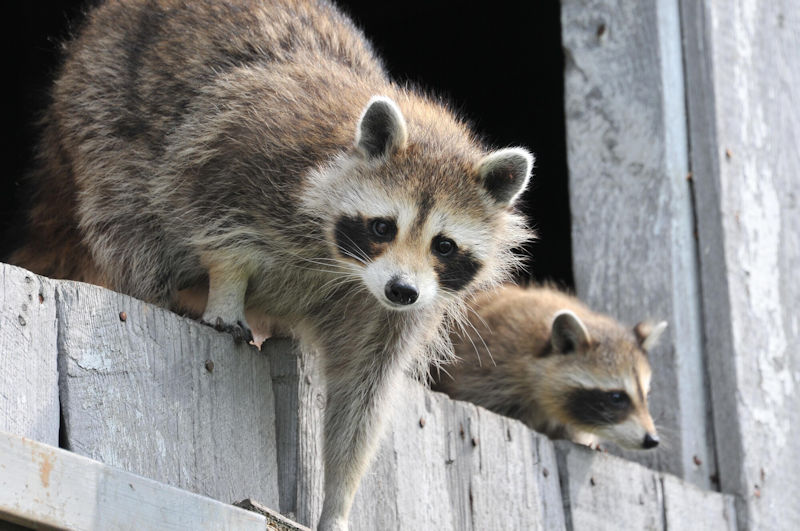If you live in an urban or suburban area, you’re probably familiar with the critters — birds, squirrels, and raccoons — that make their homes in the trees, cattails, and various nooks around your property.
Another thing you might be aware of is that these furry and feathered friends tend to get into your house from time to time. They might hop across your roof, pop in an open door or window, sneak through a hole, then get stuck and need your help leaving your home.
Raccoons are the variety of critters we’re most concerned about since they can cause all sorts of damage to your home and cause a severe health hazard to your family.
We want to make sure you understand how raccoons gain access to your roof, attic, or crawlspace and why it’s so important to remove them from your home as soon as possible. Let’s get started!
Understanding Raccoon Attic Access Points
Roof Vulnerabilities
Raccoons are excellent climbers, equipped with sharp claws and nimble bodies that can scale structures effortlessly. Your roof can be particularly vulnerable to raccoon entry if there are loose or damaged shingles, chimneys, or vents. Raccoons can easily exploit these weaknesses and make their way into your attic.
To protect your home from raccoon intrusions, it is crucial to identify and secure these entry points. Regularly inspect your roof for any signs of damage, such as missing shingles or cracks in the chimney or vents. If you notice any vulnerabilities, promptly repair them using appropriate materials. Reinforcing weak areas will significantly reduce the chances of raccoons gaining access to your attic.
Tree Limbs
If you have trees near your home, especially ones with branches that extend close to the roof, raccoons can use them as a bridge to access your attic. They have a remarkable ability to jump from trees onto nearby structures, including your house. By trimming tree limbs back and ensuring a significant distance between branches and your roof, you can create a barrier that deters raccoons from reaching your attic.
It is advisable to consult with an arborist or professional tree service to trim your trees properly. They will ensure the branches are cut to encourage healthy growth while creating a safe distance from your house.
Siding and Fascia Boards
Raccoons are notorious for finding weak spots in the siding and fascia boards of homes. They can squeeze their nimble bodies through the smallest gaps or chew into your attic. Regularly inspect your siding and fascia boards for any signs of damage or cracks that can serve as entry points for raccoons.
If you discover any weaknesses, promptly repair them using durable materials like steel mesh or heavy-gauge wire. These materials are a physical barrier, preventing raccoons from entering your attic.
The Importance of Humane Raccoon Removal
While it might be tempting to use lethal methods or DIY traps to eliminate raccoons, it is essential to prioritize humane raccoon removal. There are several reasons why humane approaches are necessary.
Firstly, using inhumane methods can cause unnecessary harm and suffering to raccoons, contravening ethical principles and animal welfare standards. Raccoons are living creatures that deserve to be treated with respect and compassion.
Secondly, many areas have specific laws and regulations that protect wildlife, including raccoons. It is illegal to kill raccoons without proper permits or authority. Opting for humane raccoon removal methods ensures you comply with these laws, avoiding potential legal consequences.
Humane raccoon removal involves using live traps to capture the raccoons safely. Once captured, the raccoons are relocated to more suitable habitats away from residential areas.
The Dangers of Raccoon Infestation
Having raccoons in your attic can pose various risks to your health and property. Understanding these risks can highlight the importance of prompt and effective raccoon removal.
- Disease Transmission: Raccoons can carry several diseases and parasites that can be transmitted to humans. Roundworm is one of the most common raccoon-related diseases, which can cause severe and fatal illnesses if ingested. Raccoon urine and feces can also contaminate your living space, potentially exposing your family to health hazards.
- Structural Damage: Raccoons are destructive by nature, and their presence in your attic can lead to extensive damage. They can tear apart insulation, chew through electrical wires, damage ductwork, and even dismantle specific structural components. Over time, their activity can compromise the integrity of your home, leading to costly repairs and maintenance expenses.
- Fire Hazards: Raccoons have been known to chew on electrical wires, including those in attics. Chewing on wires poses a significant fire hazard, as it can lead to electrical shortages and potentially ignite a fire. Protecting your home from the risk of fire and ensuring your family’s safety means addressing raccoon intrusions promptly.
Preventing Raccoons in Your Attic
- Seal Entry Points: To prevent raccoons from accessing your attic, it is crucial to identify and seal any potential entry points. Carefully inspect your roof, vents, chimney, fascia boards, and other vulnerable areas for gaps, cracks, or openings. Seal these gaps using durable materials like steel mesh or heavy-gauge wire.
- Trim Trees: As mentioned earlier, tree limbs can serve as bridges for raccoons to access your attic. Trimming tree limbs close to your house can minimize the chances of raccoons reaching your roof. Aim to keep a significant distance between tree branches and your roof to prevent raccoons from jumping onto your property.
- Secure Trash Storage: Raccoons are opportunistic feeders attracted to readily available food sources. Keeping your garbage cans secured with tight-fitting lids can deter raccoons from rummaging through your trash. Additionally, consider using animal-proof containers for storing your garbage to minimize the chances of raccoons searching for food in your vicinity.
Protect Yourself From Raccoons in Attic
Raccoons can access your attic through various entry points, posing health risks and property risks. It is crucial to take proactive measures to prevent raccoon infestations and ensure your family’s and wildlife’s safety.
Securing vulnerable areas, trimming tree limbs, and implementing preventive measures can reduce the likelihood of raccoons entering your attic. Remember, enlisting the help of a professional humane raccoon removal service is the safest and most effective way to deal with raccoon intrusions.
Act now to safeguard your home from unwanted raccoon intruders, prevent costly damages, and promote coexistence with wildlife around your property. Taking preventive measures and addressing raccoon infestations promptly is the key to protecting your attic and maintaining a safe and harmonious living environment.

